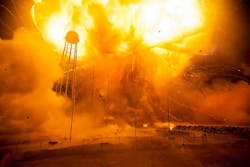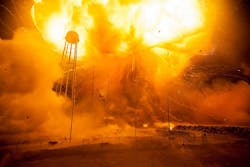COTS components in space: overcoming the fear of risk
By Dan Friedlander
Retired following 44 years in components engineering
Traditional space and military specification (MIL-SPEC) components have long proven to meet the requirements of various aerospace and defense applications; nevertheless, these successes do not come free of failures.
“99 percent of success is built on failure.” — Charles Kettering
The failures helped, among other things, the Electrical, Electronic, and Electromechanical (EEE) component policymakers to prepare entire specification/standards/handbook systems to mitigate the risk of failures. Whoever believes in the myth of "avoid failures" must revisit this term.
Risk is everywhere and the use of any EEE component in any application is not an exception. The greatest risk is really to take no risk at all.
At the timing of the space/MIL/QPL (Qualified Products List) concept establishment, the EEE components global market share (in $) of the space/MIL EEE components was 60 percent. I have difficulties believing the risk of losing availability of components was then on the agenda of the policymakers. They were focused on mitigating technical failures.
Global developments, based on manufacturers' business decisions, changed completely the space/MIL EEE components market share (in $) to less than 0.1 percent.
Photo: NASA/Joel Kowsky
This development was the main driver for the courageous William Perry, former U.S. Secretary of Defense, to take the risk and change the policy to use of commercial off-the-shelf (COTS) components in military applications. During his post-decision period, it was field proven that the not-free-of-risk decision was the right one. Unfortunately, the reform did not include space applications. Space applications were exempted, ignoring the issue of insecure components availability.
Although 23 years have passed since the above reform, the path for COTS in space has not yet been officially and fully cleared. Of course, local initiatives are always popping up here and there. The imminent change has not yet been dealt properly. The policy makers are still plagued by myths.
"The risk of a wrong decision is preferable to the terror of indecision." — Maimonides
The fear of risk
The term "Fear of Risk" is widely spread over the history of human beings. Its meaning is sometimes a positive attribute, depending on its intensity in a given context. Herein I deal with the context of fear of risk of change of policy to back up use of COTS in space.
"Fear to change is the enemy of success."
In spite of hopefully being aware of the space/MIL components availability status and trend, it seems that the issue is not alarming enough for some leaders. They are still confident that the situation is under control.
“If things seem under control, you are just not going fast enough.” — Mario Andretti
Dealing with COTS within a new methodology is a complex and time-consuming process. Decision delays have a negative impact on establishment in time of a proper infrastructure, based on the experience of the existing space/MIL infrastructure.
Quote: " If you fail to prepare, you prepare to fail."
Not being able to find needed EEE components to build space project is a failure to be treated accordingly.
Use of COTS in space dictates culture change. It is worth to consider, better sooner than later, such a change.
"If the risk is fully aligned with your purpose and mission, then it's worth considering." — Peter Diamandis
A decision to be taken is not free of risk.
"Risk comes from not knowing what you're doing." — Warren Buffett
Even if the involved people are afraid of uncertainty, they are supposed to know what is needed in the future. They should prepare the tools to meet the requirements of the space industry in a worst-case situation.
"Ask yourself if what you are doing today is getting you closer to where you want to be tomorrow"
All of us have the same target: SUCCESS. Success does not come without progressively building it.
"The road to success is always under construction." — Lily Tomlin
A strategy to reach the target shall be planned and implemented.
"The only way a strategy can get implemented is if we dedicate resources to it." — Clayton Christensen.
Risk management
Risk is manageable. Nevertheless, everyone knows that there is no such thing as zero risk. Conservatism in today's dynamic world has its own limits.
"The policy of being too cautious is the greatest risk of all." — Jawaharlal Nehru
Risk Management is a process of finding ways to mitigate assessed risks. The efficiency of this methodology is measured by the ability to reach an acceptable risk for a specific space mission.
"I think there's a difference between a gamble and a calculated risk." — Edmund H. North.
In order to manage risks one should understand very well what he is doing. Risk management is to be understood as a multidisciplinary process, based on deep technical knowledge of component engineering and other relevant disciplines.
“Not taking risks one doesn't understand is often the best form of risk management.” ― Raghuram G. Rajan
Conclusion
There is an imminent need to decide whether the dealing with the subject of use of COTS in space is satisfactory in terms of time, progress speed, infrastructure, risk management, resistance to change.
It is my opinion that resistance to change is the main factor slowing down the movement to the right direction.
"Resistance at all cost is the most senseless act there is." — Friedrich Durrenmatt
Global unpredictable events are stronger than any resistance to change.
"The art of life is a constant readjustment to our surroundings." — Kakuzo Okakaura
RELATED READING
RELATED READING
Protecting COTS space electronics at the component and module levels, a discussion
Lowering the cost of spacecraft avionics with radiation-tolerant COTS electronics
COTS/EEE parts in space applications: evolution overview, revolution forward view
Search the Aerospace & Defense Buyer's Guide
The go-to resource for Intelligent Aerospace technology news & information:
Covering key topics
Across all market segments
Subscribe to the free Intelligent Inbox e-newsletter
Subscribe to receive all the latest aerospace technology news & information, delivered directly to your e-mail inbox twice a week (Tuesdays and Thursdays). Sign upfor your free subscription to the Intelligent Inbox e-newsletter at http://www.intelligent-aerospace.com/subscribe.html.
Connect on social media
Keep pace with aerospace innovation and opportunities via your favorite social media channels. Connect with Intelligent Aerospace on Twitter (@IntelligentAero), LinkedIn,Google+, and Instagram.



